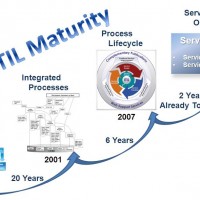
In my last post, Eat or be Eaten – IT Transformation Underway, I discussed the transformation IT as we know it is undergoing. Last week I had the opportunity to listen to my good friend Eveline Oehrlich of Forresterpresent Reboot Service Management as hosted by ITSM Academy, confirming many of the discussion points from my previous post and had me thinking about my next series of posts.
The IT is being dropped by more and more folks in the industry and ITIL is being discussed less and less due to negative feelings surrounding it. Business has reached the point of frustration hearing too much about IT, technology silos and processes at the same time the market has opened up with new buying options removing the perceived lack of competion IT has enjoyed for so long.
I initially was going to start this series with Why Business Service Management, however, after last week’s discussion led by Eveline, I also agree, to shed the IT and business delineations of the past. Now I ask myself what is it we need to focus on? Why is this transformation underway? The answer had hit me quite easily earlier this year, it’s simple. At the end of the day we need to answer a couple of simple questions:
- Are we open for business?
- How are we performing?
- What is our current level of risk?
- Are we operating efficiently?
These are the questions at the crux of this transformation into a center of innovation driving the business and a small operation managing the commodity as efficiently as possible. In slide 7 of Eveline’s deck, she discussed how technology demand is up even with declining revenues because organizations see the power that technology can bring their organization. There are 3 facets to this: Demand for technology, Growth of revenue and Decline of costs. The next few slides and discussion supported a complex environment, self service and support of technology and technology savvy workforce. The technology is moving to the business with the business buying their way into a center of innovation, leaving old IT to commoditize and operate the legacy. The credibility gap between the technology savvy business and the current IT organization is growing and thus the shift empowered by new, easy buying options.
Very few organizations perceive their current IT organizations will drive growth for their organization because most feel their IT organization does not understand the business. Businesses are seeking growth and customer loyalty far above just driving out costs in the current environment. The businesses are seeking guidance in applying technology to drive growth and are spending to see that happen. These will be the leaders of their industry in the coming year.
The most interesting chart in the conversation last week was slide 22 and where IT is placing their priorities. IT prioritizes efficiency and cost where they have a great opportunity to drive revenue, customer loyalty and competitiveness for the business in the market. I assume the folks attacking driving growth are in the minority as it is the greatest change for the current IT organization. The level of complexity to manage technology increases the more the business subscribes to their own disparate services across business units. As this gap grows, this is the point of inflection where I believe the new center of innovation will evolve from to centralize management again, but in a business fashion versus an operation fashion as we have today.
As the discussion began to come to a close, we look at slide 59 and 60 and see that 45% of organizations will have SaaS services by the end of 2012 and 60% by 2013 with businesses shifting from managing cost and focusing on business agility. This is why I found slide 22 interesting as most IT organizations are still focusing on cost. This is where I believe the center of innovation and operations for the new IT will evolve from because the current IT cannot answer the questions above and have no idea how technology impacts business. Most IT organizations manage all technology the same, box on / box off is equal to severity 1, when they should have visibility to business impact setting priority and how management focus of resources are applied.
So Why Service Management? To know if you are open, performing well, managing risk and operating efficiently. It’s about the service of your business, not the technology and the business is seeking roles, employees and service providers that drive growth, customer loyalty and market competitiveness. The question is will they hire the talent from the outside or will the inside evolve to transform the organization and become strategic to apply technology rather than just operate the technology.
It’s not just about contracting cloud services for the sake of it, but a strategy of applying the right technology, deployment option and manage it and bake that management into the service to manage and grow the business. In the next posts I’ll discuss each question in further detail focusing on:
- Are we open for business? Availability and service views and management
- How are we performing? Performance of the service both from the technology & business perspective
- What is our current level of risk? Risk both operationally and from a security perspective
- Are we operating efficiently? Leveraging automation and standards
I believe technology will fragment and decentralize before coming back together with centralized management, but it will be management of services and the application of technology to drive growth, thus the center of innovation. The business is already creating this capability, it’s just a question whether the inside folks are part of the strategic movement or left with the operational management.
How is your IT organization evolving?
Michele














